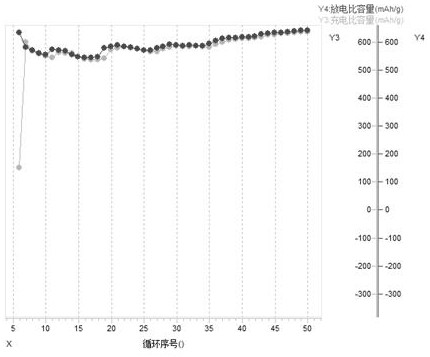Method for producing lithium battery silicon-carbon negative electrode active material by magnetic coating ball milling
A negative electrode active material, lithium battery technology, applied in battery electrodes, negative electrodes, secondary batteries, etc., can solve problems such as poor cycle performance and stability, poor silicon-carbon composite effect, and complexity, and achieve convenient operation and excellent performance. , the effect of simple preparation process
- Summary
- Abstract
- Description
- Claims
- Application Information
AI Technical Summary
Problems solved by technology
Method used
Image
Examples
Embodiment 1
[0047] (1) First mix silicon powder and iron powder evenly, then add ball milling aids and place in a ball mill with a protective atmosphere of nitrogen, ball mill for 3 hours at a speed of 920r / min and a ball-to-material ratio of 2.6:1, and then ball mill The slurry is placed in a vacuum furnace for vacuum annealing, and the product is collected to obtain powder A; the average particle size of the silicon powder is 110nm; the average particle size of the iron powder is 250nm; The proportion is, by weight, 17 parts by weight of dispersant, 6 parts by weight of adhesive, and 160 parts by weight of solvent; wherein, the dispersant is NMP, the adhesive is SBR, and the solvent is absolute ethanol; the temperature of vacuum annealing at 130°C for 36 minutes;
[0048] The ratio of each raw material is, in parts by weight, 30 parts by weight of silicon powder, 40 parts by weight of iron powder, and 190 parts by weight of ball milling aid;
[0049] (2) First place the porous carbon p...
Embodiment 2
[0054] (1) Mix silicon powder and iron powder evenly first, then add ball milling aids and place in a ball mill with a protective atmosphere of nitrogen, ball mill for 5 hours at a speed of 60r / min and a ball-to-material ratio of 2:1, and then ball mill The slurry is placed in a vacuum furnace for vacuum annealing, and the product is collected to obtain powder A; the average particle size of the silicon powder is 100nm; the average particle size of the iron powder is 200nm; The proportion is, by weight, 16 parts by weight of dispersant, 5 parts by weight of adhesive, and 180 parts by weight of solvent; wherein, the dispersant is PVP, the adhesive is PVDF, and the solvent is NMP; the temperature of vacuum annealing is 1150 ℃, the time is 38min;
[0055] The ratio of each raw material is, in parts by weight, 10 parts by weight of silicon powder, 20 parts by weight of iron powder, and 250 parts by weight of ball milling aid;
[0056] (2) First place the porous carbon powder in a...
Embodiment 3
[0061] (1) First mix silicon powder and iron powder evenly, then add ball milling aids and place in a ball mill with a protective atmosphere of nitrogen, ball mill for 1 hour at a speed of 100r / min and a ball-to-material ratio of 3:1, and then ball mill The slurry is placed in a vacuum furnace for vacuum annealing, and the product is collected to obtain powder A; the average particle size of silicon powder is 150nm; the average particle size of iron powder is 400nm; ball milling aids include dispersant, binder, solvent, and various raw materials The proportion is, by weight, 19 parts by weight of dispersant, 9 parts by weight of adhesive, and 120 parts by weight of solvent; wherein, the dispersant is sodium hexametaphosphate, the adhesive is stearic acid, and the solvent is deionized water ;The temperature of vacuum annealing is 140℃, and the time is 33min;
[0062] The ratio of each raw material is, in parts by weight, 40 parts by weight of silicon powder, 40 parts by weight ...
PUM
| Property | Measurement | Unit |
|---|---|---|
| Average particle size | aaaaa | aaaaa |
| Average particle size | aaaaa | aaaaa |
| Average particle size | aaaaa | aaaaa |
Abstract
Description
Claims
Application Information
 Login to View More
Login to View More - R&D
- Intellectual Property
- Life Sciences
- Materials
- Tech Scout
- Unparalleled Data Quality
- Higher Quality Content
- 60% Fewer Hallucinations
Browse by: Latest US Patents, China's latest patents, Technical Efficacy Thesaurus, Application Domain, Technology Topic, Popular Technical Reports.
© 2025 PatSnap. All rights reserved.Legal|Privacy policy|Modern Slavery Act Transparency Statement|Sitemap|About US| Contact US: help@patsnap.com



